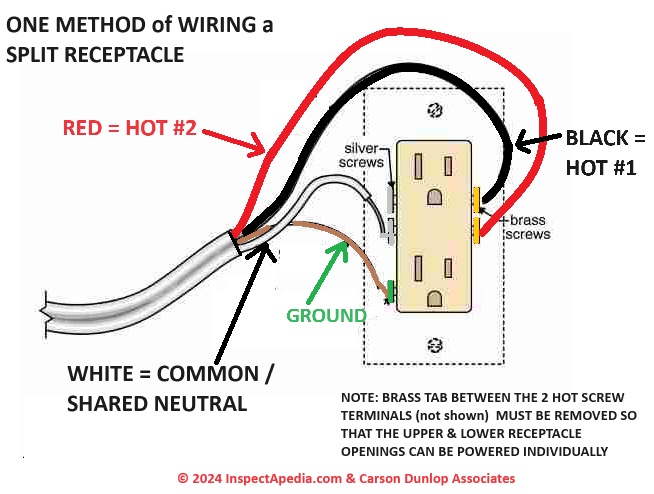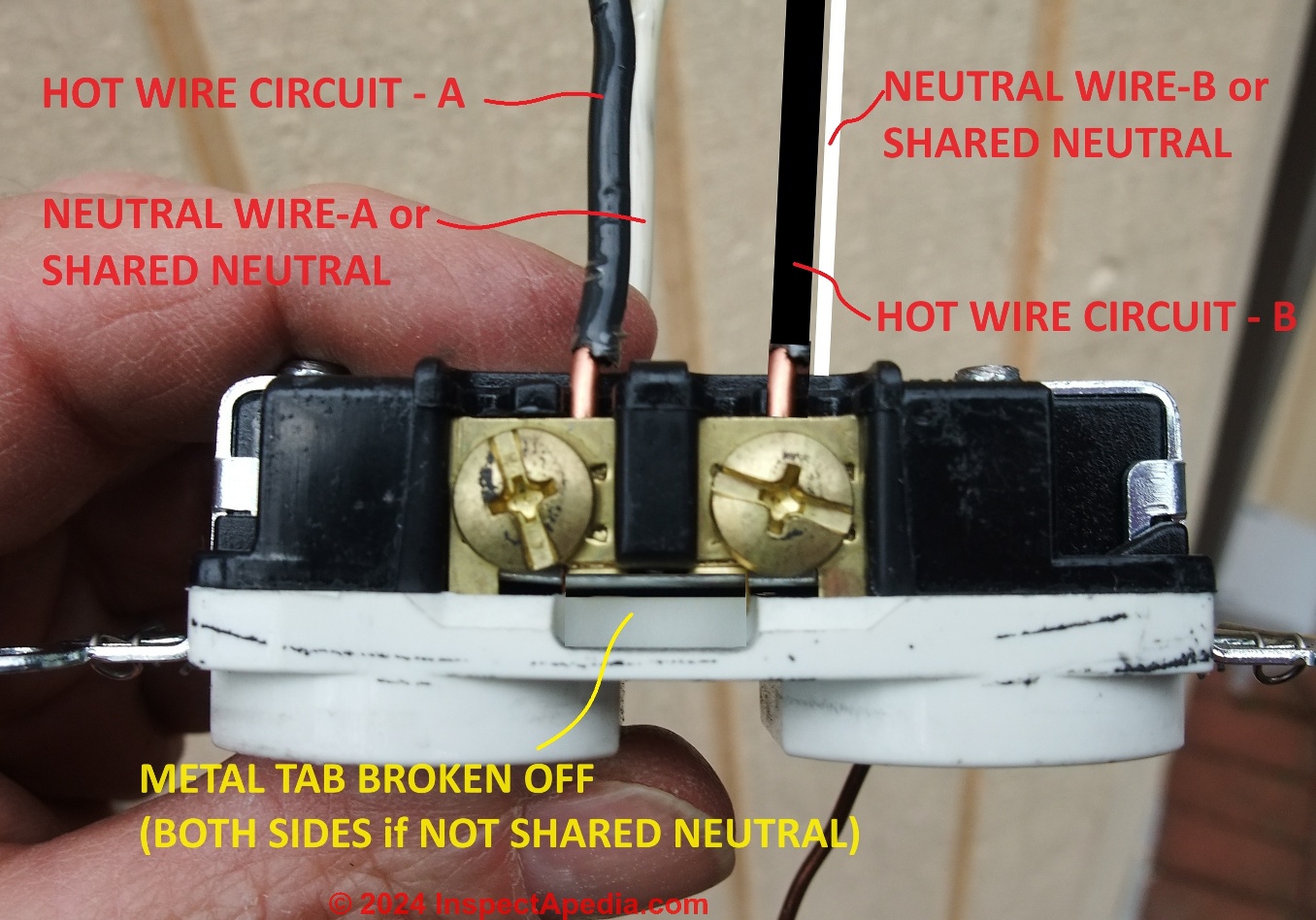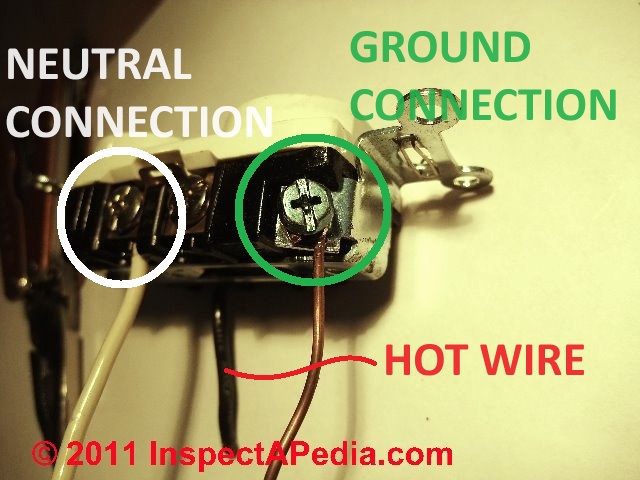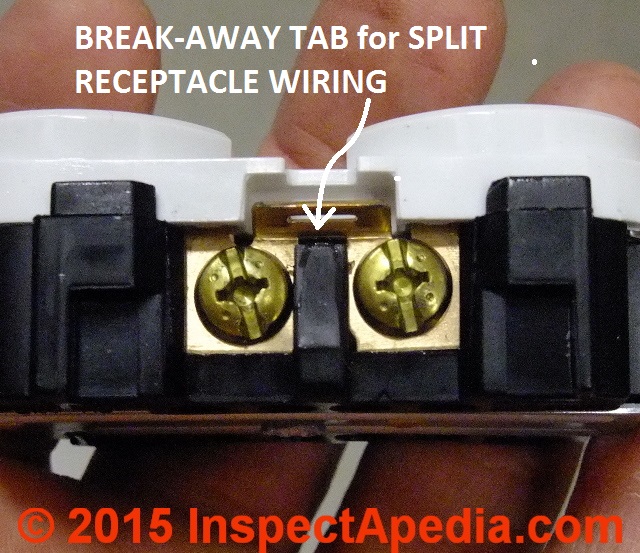 Split Receptacle Wire Connections
Split Receptacle Wire Connections
How to wire up a split receptacle allowing switch control
or
independent power & over-current protection for each receptacle opening in a duplex outlet
- POST a QUESTION or COMMENT about how to install and wire electrical outlets or receptacles in buildings.
How to wire up a split receptacle:
This article describes how an electrician may split the wiring to an individual electrical receptacle (wall outlet) so that the upper and lower halves of the device may be powered separately.
Our page top photo points out the break-away tab that is removed if we are going to wire the upper and lower halves of an electrical receptacle separately.
In this article series we illustrate basic connections seen in the field for the black, white neutral or grounded conductor), and ground wire when hooking up an electrical receptacle (wall plug or "outlet").
Watch out: mis-wired electrical receptacles are dangerous. Electrical wiring should be performed by a licensed, trained electrician and should comply with the National Electrical Code and local regulations. This article series describes how to choose, locate, and wire an electrical receptacle in a home.
InspectAPedia tolerates no conflicts of interest. We have no relationship with advertisers, products, or services discussed at this website.
- Daniel Friedman, Publisher/Editor/Author - See WHO ARE WE?
Wiring a Split Receptacle to Two Different Electrical Circuits - option for separate receptacle control
A split-wired receptacle [electrical outlet] is a duplex [two openings for plugs] electrical receptacle that has been converted functionally into two single, receptacles that are individually partly or completely electrically independent. The photograph shows a red and black wire pair powering a shared neutral circuit.
We used this wiring method in a small cabin where individual electric heaters were used for building heat. By providing separate circuits to power the upper and lower receptacle openings we could plug two heaters in at the same wall outlet without drawing too much current on either of the individual circuits.
Often we use this feature when we want to be able to switch a table or floor lamp on or off from a wall switch while keeping "always-on" power provided to the other half of the receptacle. In this application we simply interrupt the power to one of the individually powered receptacle openings - upper or lower - with a wire that goes to and from the wall switch.
For example in a bedroom we might want to plug in a wall-clock that will always have power while at the same time and at the same location we want to be able to switch a bedside table lamp on and off from a switch at the entry to the room.
Above we show one method of wiring a split duplex receptacle so that the upper and lower elements each has a separate power supply. This wiring method uses a common or shared neutral wire but two independent hot or power wires.
For some installations you may also need individual neutral wires; in that case both wiring tabs must be removed from the back of the receptacle: the tab between the two hot terminals and the tab between the two neutral terminals.
3 Easy Wiring Steps for a Split Receptacle
Split Receptacle Wiring Summary in 3 Steps: to "split" an electrical receptacle so that you can either power the upper and lower halves from different circuits, or to permit wiring the upper or lower receptacle opening to be controlled by a light switch we simply
- Break off the metal tab (shown above) that connects the upper and lower wiring terminals on both sides of the device - the copper-colored "hot" side and the silver colored neutral side.
Shown above for the "hot" (black wire) side of the receptacle we've circled in red the tab before it has been removed. Just grip the tab with a pair of pliers and bend it back and forth until it snaps off.
If you are NOT using a common neutral for the two circuits feeding this split-wired receptacle, then you will also break away the equivalent tab on the other (neutral) side of the receptacle as well.
Our next photo shows that the tab between the two hot wire screw terminals has been removed, allowing each to be powered independently. - Wire the upper half and lower halves of the receptacle separately from feeding circuits (shown below) or to and from a light switch if you want one of the openings to be controlled by a switch.
- Grounding conductor wire connection: though we've omitted it above for simplicity, remember to also connect the receptacle's ground screw to the electrical circuit grounding conductor.
Using an ordinary electrical wiring photo - not a split-wired receptacle - we show an example of the ground connection circled in green in our photo below.
More examples of wiring connections for electrical receptacles are
at ELECTRICAL OUTLET, HOW TO ADD & WIRE - home
Split Receptacle Wiring Tips:
Watch out: If you are wiring a split receptacle to provide power from two different circuits, one to the upper and another to the lower receptacle opening, it's possible to power each from a different hot wire but use a shared neutral wire provided that the hot wires are on different phases in the electrical panel. But we don't recommend this wiring for AFCIs and GFCIs. Shared neutral receptacles can give nuisance tripping, particularly if the receptacle is an AFCI or GFCI device.
Watch out: if you do use a multi-wire circuit (shared neutral) to power a split receptacle, the two phases are wired to the same electrical receptacle (upper portion to one phase, lower to another phase, by breaking the tie on the receptacle sides) then a common-trip circuit breaker should be used on that circuit.
See details at MULTI-WIRE CIRCUITS
Watch Out: Electrical components in a building can easily cause an electrical shock, burn, or even death. Even when a hot line switch is off, one terminal on the switch is still connected to the power source. Before doing any work on the switch, the power source must be turned off by setting a circuit breaker to OFF or removing a fuse.
...
Reader Comments, Questions & Answers About The Article Above
Below you will find questions and answers previously posted on this page at its page bottom reader comment box.
Reader Q&A - also see RECOMMENDED ARTICLES & FAQs
Question: how do I wire a switched electrical receptacle?
I have double receptacle that has 3 wires coming in: one being the main power wire; one is incoming which feeds another receptacle, and the 3rd wire will feed a single pole switch. How do I wire the receptacle and then, how do I wire the single pole switch with 2 incoming wires? - JMS 6/3/12
Reply:
JMS I don't have a perfectly clear idea of what you are wiring, but it may help to simplify: using a twist on connector and additional short wire lengths, the incoming hot and neutral can then be connected to receptacles in the same box, and any outgoing hot and neutral join the same twist on connectors.
Typically when I see a switch wired from a receptacle box the switch is being used to make one of the receptacles switchable while leaving the others always -on. in that case the electrician may run a 14-2 wire (hot, neutral, ground) from the receptacle box to the switch, putting black tape on the ends of the white wire to show that BOTH wires are actually carrying current.Those wires, back in the receptacle box, then interrupt power to the "switched" receptacle.
If you choose to wire the upper and lower duplex receptacle openings to different circuits, we call this the "split receptacle" wiring method, because we are splitting the individual duplex receptacle upper and lower connectors onto two different circuits.
We split an individual receptacle at a single location when we want to control the upper or lower receptacle half to permit turning a wall or floor lamp on or off from a wall-mounted light switch.
Our photo above shows the black wire or "hot" wire brass screws on an electrical receptacle with the conducting tab left in place.
In this factory-configuration, a wire connected to either of the two screw connectors will power both upper and lower halves of this receptacle.
But if we break away the red tab pointed to by my red arrow, then we can wire the top and bottom half of this receptacle separately.
Depending on the application and on what circuits and wires are present, we might break away only the line or hot wire side of the receptacle, powering each half separately but allowing the device to use a common neutral wire. That would be a typical approach if we were going to power half of this receptacle through a wall switch.
In sum: we were wiring this electrical "outlet" as a split receptacle, we'd want to feed the upper and lower halves of the device from two different electrical circuits.
To do so we'd have to break away the "breakaway" connecting tab circled in red in my photo.
Daniel
Reader Question: how to wire up two different circuit-powered receptacles in one electrical box
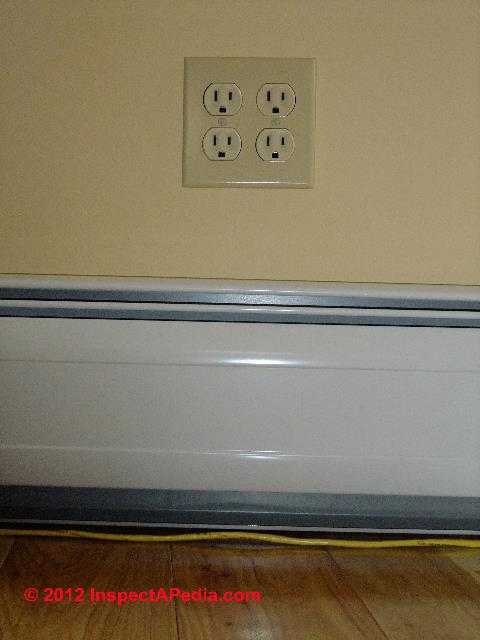 I would like to wire 2 single plugins to each have separate power: How do i do that? - Channing
I would like to wire 2 single plugins to each have separate power: How do i do that? - Channing
Reply:
Channing, re Hooking up a Pair of Receptacles in One Electrical Box:
If your two plugins (two electrical receptacles) are located in the same electrical box (we call this a "quad" electrical receptacle installation since each individual receptacle provides connections for two wall plugs), you'll want to wire the hot and neutral to one pair of screws on the first receptacle, and use short black and white jumper wires to connect the the proper terminals on the first receptacle to the second one in the same box.
That's a perfectly acceptable use of the second pair of screw terminals you see on the receptacles.
The ground wire can be continuous, tying the two ground screws on the receptacles together and onwards to the circuit ground.
However a better practice when wiring up a quad-plex of electrical receptacles is to place left and right or upper and lower receptacles on separate electrical circuits - thus reducing the chances
There are two approaches: you can wire the left and right duplex receptacles each to different individual electrical circuits, or you can wire the upper and lower half of the pair of duplex receptacles to different electrical circuits.
Wiring a Split Receptacle to Two Different Electrical Circuits
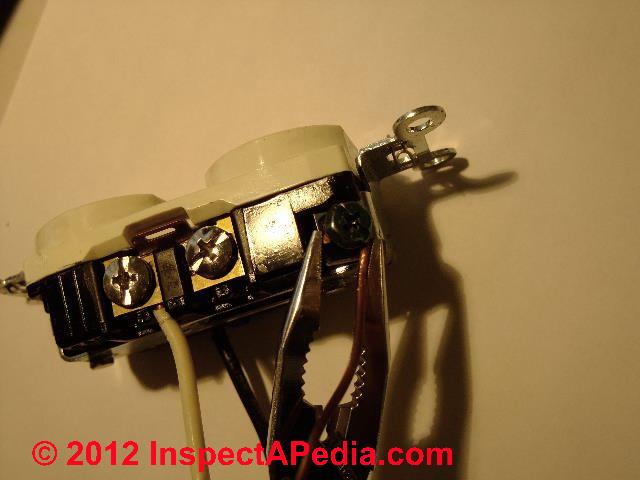 If you choose to wire the upper and lower duplex receptacle openings to different circuits, we call this the "split receptacle" wiring method, because we are splitting the individual duplex receptacle upper and lower connectors onto two different circuits.
If you choose to wire the upper and lower duplex receptacle openings to different circuits, we call this the "split receptacle" wiring method, because we are splitting the individual duplex receptacle upper and lower connectors onto two different circuits.
Our photo (left) shows an electrical receptacle that is being wired to a single circuit. The white neutral wire is connected to the silver screw (left side of our photo).
If we were wiring this electrical "outlet" as a split receptacle, we'd want to feed the upper and lower halves of the device from two different electrical circuits.
To do so we'd have to break away the "breakaway" connecting tab pointed to by our orange arrow.
Daisy Chaining Receptacles in Separate Electrical Boxes
If your two receptacles are in different locations and thus in different electrical boxes, your circuit that wires the second or "downstream" receptacle can be powered by those same extra terminal screws on the first or "upstream" receptacle.
You'll need to run a wire from the first receptacle through the wall into the second electrical box of course.
Wiring Electrical Receptacles on a Single Circuit In Parallel
In some jurisdictions electricians to not "daisy chain" receptacles in the same box together by using the second pair of screws on each one. Rather the circuit enters the box and using twist-on connectors, short pig-tail wires are connected to each receptacle at the proper screws.
This approach requires a larger electrical box as it will contain more connections, connectors, and so needs more room.
Because electricians often pull a multiwire circuit where they plan to split receptacle circuits within an individual electrical box while sharing a neutral wire, be sure to ake a look at multi-wire branch circuit wiring information and hook-up details
What happens when I break off the tabs on a duplex receptacle?
If i have a receptacle and i break the tabs off and my breaker trips will one part stay energized or am i understanding this wrong as to why i need a handle tie. On 2012-10-23 by Jose A. Guillen
Reply by (mod)
When you break off the tabs on a duplex electrical receptacle then each receptacle half (upper vs lower or if horizontal, left vs right) will need to be powered by a wire directly. If you power each half from a different electrical circuit then you've set up what we call a split receptacle.
See wiring details above on this page.
...
Continue reading at ELECTRICAL RECEPTACLE CONNECTION DETAILS or select a topic from the closely-related articles below, or see the complete ARTICLE INDEX.
Or see these
Recommended Articles
- ELECTRICAL OUTLET, HOW TO ADD & WIRE - home
- ELECTRICAL OUTLET ADAPTER SHORT CIRCUIT
- ELECTRICAL RECEPTACLE ARC PITTING
- ELECTRICAL RECEPTACLE CONNECTION DETAILS
- 2-WIRE RECEPTACLE CONNECTIONS
- WHICH SCREWS GET the BLACK, WHITE & GROUND WIRES ?
- WHICH WIRES GO to LINE or LOAD CONNECTIONS?
- HOW to CONNECT WIRES to a RECEPTACLE or SWITCH
- GROUND WIRE CONNECTION SUMMARY
- NUMBER of WIRES NEEDED: 2-WIRE, 3-WIRE, 2 or 3 WITH GROUND?
- ELECTRICAL DUPLEX RECEPTACLE WIRING
- ELECTRICAL OUTLET, HOW TO ADD in OLDER HOME
- ELECTRICAL RECEPTACLE WIRING SERIES vs PARALLEL
- ELECTRICAL SPLIT RECEPTACLE WIRING
- WIRES TOO SHORT TO CONNECT, REPAIR FOR
- GROUND WIRE CONNECTIONS
- MULTI-WIRE CIRCUITS
Suggested citation for this web page
ELECTRICAL SPLIT RECEPTACLE WIRING at InspectApedia.com - online encyclopedia of building & environmental inspection, testing, diagnosis, repair, & problem prevention advice.
Or see this
INDEX to RELATED ARTICLES: ARTICLE INDEX to ELECTRICAL INSPECTION & TESTING
Or use the SEARCH BOX found below to Ask a Question or Search InspectApedia
Ask a Question or Search InspectApedia
Try the search box just below, or if you prefer, post a question or comment in the Comments box below and we will respond promptly.
Search the InspectApedia website
Note: appearance of your Comment below may be delayed: if your comment contains an image, photograph, web link, or text that looks to the software as if it might be a web link, your posting will appear after it has been approved by a moderator. Apologies for the delay.
Only one image can be added per comment but you can post as many comments, and therefore images, as you like.
You will not receive a notification when a response to your question has been posted.
Please bookmark this page to make it easy for you to check back for our response.
IF above you see "Comment Form is loading comments..." then COMMENT BOX - countable.ca / bawkbox.com IS NOT WORKING.
In any case you are welcome to send an email directly to us at InspectApedia.com at editor@inspectApedia.com
We'll reply to you directly. Please help us help you by noting, in your email, the URL of the InspectApedia page where you wanted to comment.
Citations & References
In addition to any citations in the article above, a full list is available on request.
- Timothy Hemm has provided photographs of various electrical defects used at the InspectAPedia TM Website. Mr. Hemm is a professional electrical inspector in Yucala, CA.
- Mark Cramer Inspection Services Mark Cramer, Tampa Florida, Mr. Cramer is a past president of ASHI, the American Society of Home Inspectors and is a Florida home inspector and home inspection educator. Mr. Cramer serves on the ASHI Home Inspection Standards. Contact Mark Cramer at: 727-595-4211 mark@BestTampaInspector.com
- John Cranor [Website: /www.house-whisperer.com ] is an ASHI member and a home inspector (The House Whisperer) is located in Glen Allen, VA 23060. He is also a contributor to InspectApedia.com in several technical areas such as plumbing and appliances (dryer vents). Contact Mr. Cranor at 804-873-8534 or by Email: johncranor@verizon.net
- [3] NFPA - the National Fire Protection Association can be found online at www.nfpa.org
- [4] The NEC National Electrical Code (ISBN 978-0877657903) - NFPA might provide Online Access but you'll need to sign in as a professional or as a visitor)
- US NEC Free Access: See up.codes at this link: https://up.codes/code/nfpa-70-national-electrical-code-2020
- [5] Special thanks to our reader Steve who pointed out prior errors in our illustrations.
- [6] Simpson Strong-Tie, "Code Compliant Repair and Protection Guide for the Installation of Utilities in Wood Frame Construction", web search 5/21/12, original source strongtie.com/ftp/fliers/F-REPRPROTECT09.pdf, [copy on file as /Structures/Framing/Simpson_Framing_Protectors.pdf ]. "The information in this guide is a summary of requirements from the 2003, 2006 and 2009 International Residential Code (IRC), International Building Code (IBC), International Plumbing Code (IPC), International Mechanical Code (IMC), 2006 Uniform Plumbing Code (UPC) and the 2005 National Electrical Code."
- "Electrical System Inspection Basics," Richard C. Wolcott, ASHI 8th Annual Education Conference, Boston 1985.
- "Simplified Electrical Wiring," Sears, Roebuck and Co., 15705 (F5428) Rev. 4-77 1977 [Lots of sketches of older-type service panels.]
- "How to plan and install electric wiring for homes, farms, garages, shops," Montgomery Ward Co., 83-850.
- "Simplified Electrical Wiring," Sears, Roebuck and Co., 15705 (F5428) Rev. 4-77 1977 [Lots of sketches of older-type service panels.]
- "Home Wiring Inspection," Roswell W. Ard, Rodale's New Shelter, July/August, 1985 p. 35-40.
- "Evaluating Wiring in Older Minnesota Homes," Agricultural Extension Service, University of Minnesota, St. Paul, Minnesota 55108.
- "Electrical Systems," A Training Manual for Home Inspectors, Alfred L. Alk, American Society of Home Inspectors (ASHI), 1987, available from ASHI. [DF NOTE: I do NOT recommend this obsolete publication, though it was cited in the original Journal article as it contains unsafe inaccuracies]
- "Basic Housing Inspection," US DHEW, S352.75 U48, p.144, out of print, but is available in most state libraries.
- In addition to citations & references found in this article, see the research citations given at the end of the related articles found at our suggested
CONTINUE READING or RECOMMENDED ARTICLES.
- Carson, Dunlop & Associates Ltd., 120 Carlton Street Suite 407, Toronto ON M5A 4K2. Tel: (416) 964-9415 1-800-268-7070 Email: info@carsondunlop.com. Alan Carson is a past president of ASHI, the American Society of Home Inspectors.
Thanks to Alan Carson and Bob Dunlop, for permission for InspectAPedia to use text excerpts from The HOME REFERENCE BOOK - the Encyclopedia of Homes and to use illustrations from The ILLUSTRATED HOME .
Carson Dunlop Associates provides extensive home inspection education and report writing material. In gratitude we provide links to tsome Carson Dunlop Associates products and services.


